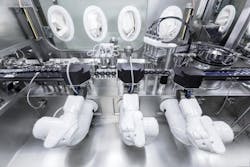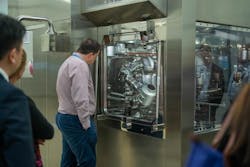While pharma has made tremendous strides in aseptic processing, the industry still struggles with contamination issues — indicating there is more work to be done. Like all segments of the pharma industry, aseptic manufacturing continues to be transformed by disruptive technologies. With the goals of maintaining compliance, lowering costs, and streamlining processes always at the top of mind for drugmakers, industry vendors are innovating solutions that incorporate the latest trends and capabilities.
“Firms are striving to reduce costs and improve process flexibility, while fundamentally eliminating some of the potential contamination challenges,” says Ben Wylie, senior product manager at ChargePoint Technology.
Pharma may be close to mastering aseptic manufacturing, but innovative tweaks and updates to equipment and operations are helping improve the process even more.
Robotics
Robots have been a game-changer in the packaging department of facilities, and are now transforming the filling process as well.
“Robotics are progressively more available in aseptic processing due to the flexibility they allow — saving time for the operator who would otherwise need to change parts to fill very different kind of vials, syringes and cartridges,” says Federico Fumagalli, chief commercial officer at Steriline. “With robotics machines, they just have to change a single parameter on the robot to change the whole production process.”
Steriline’s Robotic Vial Filling Machine was designed specifically to address the industry’s growing need for flexibility. According to the company, the machine can be equipped with one or two Stäubli vaporized H2O2 resistant anthropomorphic robotic arms (depending on output requirements), which transport the vials within the machine.
Steriline’s Robotic Vial Filling Machines are designed for campaign production with containment technology and feature vial transport with an anthropomorphic robot.
Although Fumagalli says there are pros and cons to using robotics, a cost-benefit analysis favors robots because they can reduce downtime, prevent product loss and decrease waste.
“In case a vial is not correctly stoppered, the robot can repeat the stoppering cycle to complete the process,” he says. “On a traditional machine the vial would be rejected — the content discarded — losing a potential earning, and the company would have to dispose of the waste, incurring further costs. Using a robotic system, the vial could go backwards and be stoppered during a second cycle, without any waste.”
Fedegari Technologies has also been developing ways to combo advanced solutions, including robotics, into one piece of machinery.
“The manufacturing processes of the future will streamline new technologies like robotics, artificial intelligence and IoT, into an increasingly closed and connected production process,” says Jeffrey Siterlet, managing director of Fedegari Technologies in North America. “By linking components, isolating the process and centralizing control, tomorrow’s manufacturing process will facilitate efficiency, safety and compliance while eliminating risk.”
The company’s new washer sterilizer, for example, offers sterilization, washing and bio-decontamination in one solution. The gloveless sealed isolator hosts a GMP robotic arm that can be adapted for different batch sizes and simplifies cleaning requirements needed to enter a controlled-contamination environment.
Single-use
Single-use solutions continue to play a dominating role in pharma manufacturing innovations and provide a wide variety of benefits.
“As single-use and disposable products become more widely utilized, the manufacturing process becomes more efficient through quicker changeovers and set-up times and drug manufacturers can react more rapidly to product and customer demands,” says Wylie.
ChargePoint recently added two products to its single-use portfolio including the ChargePoint Single Use Passive (SUP) and ChargeBag PE-S with new HiPure ULP7 PE film. Together, the two products are intended to form a high performance, single-use package for the contained and sterile transfer of powders between manufacturing process steps or even facilities.
Fedegari’s new washer sterilizer features a cluster tool concept with a gloveless robotic isolator suitable for multiple formats and various batch sizes.
The company says that the ChargePoint SUP is a disposable version of the passive mating half of the ChargePoint SBV (Split Butterfly Valve) technology, which forms a complete hybrid system to ensure users can take advantage of the benefits of disposable technology.
“Technologies such as SBVs are increasingly replacing traditional open transfer techniques, enabling contained and efficient materials transfers,” Wylie says.
Importantly, single-use innovations are also happening for the final stage of the manufacturing process: Transport.
“As the trend of biologics being manufactured in one location and going through the final fill process in another grows, the need for materials that can withstand manipulation at temperatures down to -86 degrees C continues to accelerate,” says Alex Kakad, product marketing manager for AdvantaPure.
AdvantaSil Ultra Low Temperature Silicone Tubing is designed to remain flexible (as opposed to cracking and leaking fluids) at temperatures as low as -112°C. According to the company, its tubing and molded closure assemblies have glass transition temperatures below -100 °C, allowing for a comfortable safety factor for these demanding applications. This, AdvantaPure says, makes the tubing an optimal choice for applications related to bulk drug storage and transport.
From the first stages of aseptic processing until products exit the factory doors, technology trends are continuing to transform sterile pharma operations.








